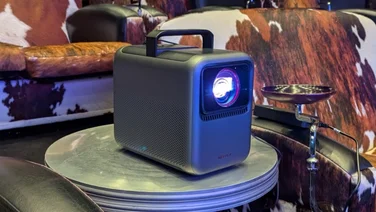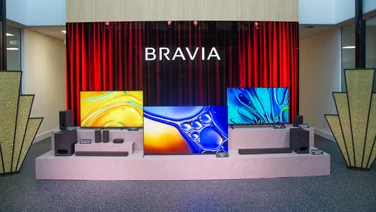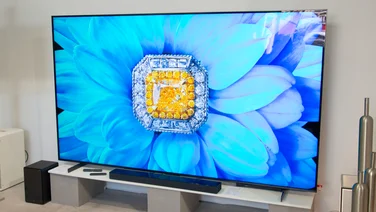To help us provide you with free impartial advice, we may earn a commission if you buy through links on our site. Learn more










- Ultra-low input lag
- Great HDR presentation
- HDMI 2.1 for next-gen consoles
- No Dolby Vision
- Mild dirty screen effect
- No Ultra Wide Viewing Angle layer
Choosing a Samsung QLED TV in 2020 is no easy task. The South Korean juggernaut has eight separate models to choose from in the UK and, if you count the different sizes, youre looking at over 30 individual TVs. So, where does the Q80T fit in? Smack bang in the middle. The Q80T is a mid-range 4K HDR TV that packs many of the premium features found on Samsungs flagship QLEDs, including full-array local dimming backlighting and HDMI 2.1 next-gen gaming features, but significantly drops the price. Keep reading to find out why its the best-value 4K QLED on the market right now.
Samsung Q80T: Key specifications | |
| Screen sizes available: | 49in QE49Q80TATXXU, 55in QE55Q80TATXXU, 65in QE65Q80TATXXU, 75in QE75Q80TATXXU, 85in QE85Q80TATXXU |
| Panel type: | VA-type QLED (LCD LED-lit, quantum dot) |
| Resolution: | 4K/UHD (3,840 x 2,160) |
| Refresh rate: | 120Hz (55in, 65in,75in, 85in), 60Hz (49in) |
| HDR formats: | HDR10, HDR10+, HLG |
| Audio enhancement: | Dolby Digital 5.1, Dolby Atmos, Object Tracking Sound |
| HDMI inputs: | 3 x HDMI 2.0, 1 x HDMI 2.1 (49in only has HDMI 2.0) |
| Streaming services: | Netflix, Disney Plus, Amazon Prime Video, BT Sport, Apple TV, Now TV, BBC iPlayer, ITV Hub, All 4, My5, YouTube etc. |
| Tuners: | Analogue, Samsung TV Plus |
| Gaming features: | VRR (FreeSync), ALLM (49in has no VRR) |
| Wireless connectivity: | Wi-Fi 5 802.11ac, Bluetooth 4.2 |
| Smart platform: | Tizen 5.5 |
| Smart voice assistants: | Samsung Bixby, Google Assistant, Amazon Alexa |
Samsung Q80T review: What you need to know
The Q80T 4K QLED TV is Samsungs most affordable 2020 television with a full-array local dimming (FALD) backlight. You might think that the Q80T would logically be the 2020 replacement for 2019s Q80R. Not so. In terms of its price and specifications, the Q80T is the spiritual successor to last years Samsung Q70R; it has FALD but no Ultra Wide Viewing Angle layer or Ultra Black Filter.
Its available in 49in, 55in, 65in, 75in and 85in variants for this review, weve tested the 55in model. Why not test the cheaper 49in instead? Well, the 49in model only has a native refresh rate of 60Hz, has no HDMI 2.1 inputs and does not support Variable Refresh Rate (VRR), whereas the 55in and up models have a 120Hz refresh rate and support next-gen gaming features.
Like all Samsungs QLED TVs, the Q80T runs Tizen OS (currently on version 5.5), giving you access to the vast majority of paid streaming platforms and free UK catch-up apps. As for HDR formats, the Q80T supports HDR10, HDR10+ and Hybrid-Log Gamma, and you can enjoy Dolby Atmos audio through a soundbar or surround sound system via the eARC HDMI port.
Samsung Q80T review: Price and competition
The Q80Ts price has dropped significantly since its launch earlier in the year, with the entry-level 49in going for just £799 (at the time of writing) down from an RRP of £1,399. Since that model doesnt have HDMI 2.1 or VRR and is capped at 60Hz, though, we recommend going for at least the 55in model on test here. Originally £1,599, you can now pick up the Q80T 55in for only £899, a hefty £700 reduction. Keep a beady eye out during the Black Friday sales, when theres a chance these prices will drop further still.
One of the Samsung Q80Ts closest rivals is the Sony XH90, a 2020 LED-lit LCD TV with full-array local dimming and HDMI 2.1 support for next-gen gaming. We reviewed the Sony XH90 75in model at £2,199, but thats since come down to £1,599. And as for the Sony XH90 55in, its now only £899.
Finally, if you want the impeccable contrast and wide viewing angles of an OLED, its well worth considering the LG BX OLED. Now £1,099 for the 55in, it offers all the same HDMI 2.1 features as the Q80T and adds in support for Nvidia G-Sync. It doesnt have HDR10+ but you get Dolby Vision in its place more than a fair trade and you also get an extra HDMI 2.1 port for your money.
Samsung Q80T review: Design and features
The semi-glossy 55in panel on our Q80T is bordered by an impressively slim metallic bezel, and the whole thing rests on a central T-bar pedestal stand. While the stem is hard plastic, the rectangular base is made of thick, heavy steel and brings plenty of stability. Having a central stand also makes it much easier to fit the TV on most AV furniture.










Due to the FALD LED backlighting behind the panel, the chassis does have a fair amount of bulk to it, especially compared to Samsungs edge-lit models. However, from the front, it looks every bit as sleek and premium as youd expect from a TV of this price.
All the connections are located on the right rear side of the display, including four HDMI ports. Of these, HDMI 3 is eARC (enhanced Audio Return Channel) and HDMI 4 is HDMI 2.1. This socket, which has a bandwidth of 40Gbps, can support 4K@120Hz at 10-bit 4:4:4. This makes it an ideal companion for the PS5 and Xbox Series X, and well talk more about that later in the review.










The Q80T runs Samsungs Tizen OS smart TV platform, granting access to all the key streaming platforms including Netflix, Disney Plus, Amazon Prime Video, Now TV and YouTube, plus the usual roster of UK TV catch-up apps.
Sound quality from the Q80Ts six speakers is above average for a flat-screen TV, although dialogue can sometimes get swamped in bass-heavy scenes. Samsung has made big claims about the Object Tracking Sound in its new QLEDs, and thats nice to have, but its no substitute for a standalone soundbar.
READ NEXT: The best soundbars and soundbases
Samsung Q80T review: Image quality
The Q80T uses a VA-type LCD panel with an RGB subpixel structure. This means it can deliver deep blacks by LED LCD standards. However, it has narrower viewing angles than IPS-type and OLED panels and doesn’t come equipped with the Ultra Wide Viewing Angle compensation film seen on pricier Samsung QLEDs such as the Q95T. In other words, the panel looks great when watching head-on but loses contrast and vibrancy when viewed off-axis.
The full-array local dimming backlight consists of 50 independently controlled dimming zones, exactly the same number as last years Samsung Q70R 55in. Samsungs local dimming algorithm prioritises minimising blooming artefacts and keeping the letterbox bars as inky black as possible. It provides an appealing, clean look to onscreen images though its not without its downsides, as sometimes shadow detail can look indistinct and small bright highlights appear darker than they should.










Occasionally, the local dimming algorithm would get tripped up by more challenging material, causing visible luminance fluctuations, for example during the opening sequence of Gravity, when Sandra Bullocks character is spinning through space. There was also an isolated incident of spasmodic flickering all over the screen during a scene in The Boys which featured rapidly flashing overhead lights.
Still, the local dimming has been noticeably improved over last year’s Q70R, and Samsung has also improved the TVs ability to differentiate between actual content and the user interface, helping it to reduce blooming and backlight fluctuation around subtitles.
The most accurate of the Q80Ts picture modes is Movie and we recommend switching over to that from Standard to enjoy more natural-looking colours right out of the box. Following calibration, we measured an average DeltaE of 1.57 on a colour checker SG chart across 140 patches, and only a handful of colours exceeded the humanly perceptible threshold DeltaE of 3. This translates to vivid, realistic colours and skin tones across a wide variety of content.
ALSO CONSIDER: Samsung Q85T 55in
The Q85T is more expensive than the Q80T but it adds two key features. First of all, it benefits from an Anti Reflection film, which does a much better job of fending off distracting reflections. Secondly, its Ultra Wide Viewing Angle layer provides wider viewing angles than the Q80T. And then there’s native contrast; the Q85T has a higher contrast level of ‘Direct Full Array 12x’, whereas the Q80T 55in has ‘Direct Full Array 8x’.
£999
Currys PC World
Even with all motion settings off, panning shots in 24p films were presented smoothly without judder, a major improvement over last year’s Samsung QLEDs, which required you to activate the Auto Motion Plus setting which, incidentally, has now been renamed Picture Clarity. By engaging Picture Clarity settings, you can boost the Q80Ts motion resolution from 300 lines to at least 1,080 lines or potentially even higher our test pattern maxes out at 1,080.
Samsung has made great strides with its motion processing technology and its 2020 QLEDs (the Q80T included) present significantly fewer motion glitches than Samsung TVs in recent years. With that said, we still noticed the odd micro-stutter while viewing 50Hz television broadcasts and this persisted whether Picture Clarity settings were turned off on.
Upscaled standard definition content looks great on the Q80T, which comes as no surprise upconversion has long been one of Samsungs key strengths. The Q80Ts Quantum Processor 4K squeezes an impressive level of detail out of a 704 x 576 broadcast without adding excessive ringing around objects and it was especially forgiving of heavily compressed films and shows, making it possible to watch them in a tolerable manner.
Our Q80T review sample had above average screen uniformity for an LED LCD panel as it exhibited only mild dirty screen effect (DSE) when displaying full-field grey slides, along with a little darkening along the sides. This didnt bother us when watching real-world content; the bright Tatooine desertscapes in The Mandalorian S1 Ep 5 looked even across the whole panel, as did the snow blown tundras of Disneys Frozen.
Samsung Q80T review: HDR performance
Like all of Samsungs QLED HDR TVs, the Q80T has multi-HDR support for HDR10, HDR10+ and Hybrid-Log Gamma (HLG), but misses out on Dolby Vision. Its quite the drawback because Dolby Vision is considered the most premium HDR format and, without it, youll be limited to HDR10 on platforms like Netflix and Disney Plus that dont support HDR10+. Thankfully, Amazon Prime Video and Google Play Movies & TV both have a wide range of HDR10+ content to enjoy.
For HDR, peak brightness measured at 862cd/m2 on a 10% window and 505cd/m2 full-screen, making it significantly brighter than last years Samsung Q70R. This means that HDR shows, movies and games on the Q80T look even more impactful than before.










The Q80Ts colour presentation remains the same as the Q70R, however, with a DCI-P3 coverage of 93% and a Rec.2020 coverage of 73%. Samsung has overhauled its 10-bit gradation compared to last year so the Q80T and indeed all other 2020 QLEDs from Samsung look smoother than ever in terms of colour gradient.
Even in HDR content mastered at 4,000 nits, the Q80T retains all specular highlights details, although the TVs default factory settings make these look brighter than reference. Ironically, this actually led to some clipping with the brightest highlight details.
The good news? Samsung now allows dynamic tone mapping to be disabled for more strictly accurate reproduction of HDR material. If you switch the Q80Ts Local Dimming setting from Standard (the default) to High, it will disable dynamic tone mapping, thus preserving more detail within, especially bright areas on-screen. This wasnt even an option on the Q70R, where dynamic tone mapping was active at all times. If youre as obsessed with accuracy as us, this is a most welcome addition.
Samsung Q80T review: Gaming
As mentioned earlier, the Samsung Q80T supports the key next-gen HDMI 2.1 gaming features of the Xbox Series X and PlayStation 5, specifically ALLM, VRR and 4K@120Hz. All you have to do is connect your console to HDMI 4, which is marked out with a console controller logo.
ALLM, or Auto-Low Latency Mode, boots the TV into its low-latency Game Mode when compatible consoles are connected in order to speed up response times. With Game Mode engaged, we measured a lightning-quick input lag of just 12ms on a 4K 60Hz signal. Meanwhile, VRR (Variable Refresh Rate) allows the panel to match its refresh rate to the frame rate of the game, eliminating screen tearing.










More obviously, 4K@120Hz support means the Q80T can display games on a 4K signal at up to 120 frames per second. It is worth noting that next-gen console games are unlikely to hit anywhere near 120fps when running at 4K; at this point, its more of a theoretical than an actual possibility.
Samsung is the only TV manufacturer to allow for a small dose of motion interpolation in Game Mode, which can be activated by engaging Game Motion Plus. However, doing so more than doubles the input lag to around 28ms. Still, some gamers may prefer to use such interpolation to smooth out stutter in 30fps games.
Samsung Q80T review: Verdict
Theres very little to complain about with the Q80T. Its a competent all-rounder and, now that its fallen so heavily in price, its the best 55in TV you can get for under £1,000. Of course, Dolby Vision support would be nice, but thats not going to appear on any Samsung TV for the foreseeable future.
Overall, this a solid improvement on last years Q70R, which the Q80T directly replaces, offering higher peak brightness, better motion handling, dynamic tone mapping controls, reduced input lag and HDMI 2.1 support for next-gen console gaming and all for a lower price too. If youre planning on buying a PS5 or Xbox Series X, the Q80T is a solid, future-proof choice.







